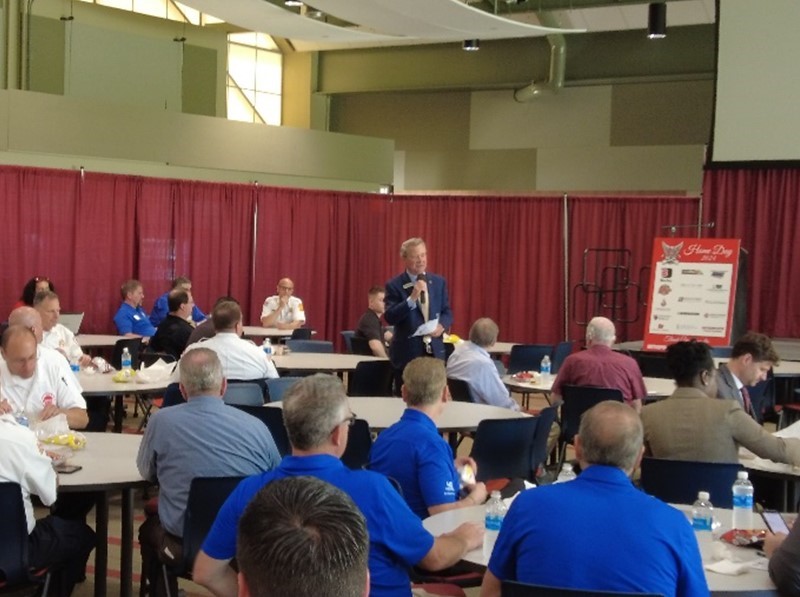RIVER GROVE, Illinois (June 6, 2024) – More than 100 representatives from Illinois’ fire service organizations gathered in River Grove for the Metropolitan Fire Chiefs Association of Illinois’ 18th Annual Fire Services Home Day, held this year at Triton College’s EMT/Fire Science Program Building.
The fire professionals were joined by elected officials and staffers from a number of state and federal offices with 18 fire service vendors displaying key equipment used in the fire service.
Paul Darley, President and CEO of Darley, a fire and defense equipment supplier in Itasca, Illinois, founded and co-chairs the annual event with retired Schiller Park Fire Chief Tom Deegan.
Various pieces of equipment and vehicles were on display during the event and were all purchased through funds from the Assistance to Firefighters Grant during the past 20 years. The events are held to keep fire service issues in front of Illinois’ federal and state legislators. U.S. Representative Sean Casten addressed the attendees with other legislators and members of their staff were in attendance.

According to the FAMA (Fire Apparatus Manufacturers’ Association) FEMSA (Fire and Emergency Manufacturers and Services Association) Government Affairs Committee, “The Assistance to Firefighters Grant Program was established by Congress in 2001 to assist communities in equipping our nation’s first responders, including firefighters and EMS personnel.” Local fire departments are able to apply for grants to purchase new and needed equipment to replace older, outdated equipment that no longer meets the safety standards of the National Fire Protection Association (NFPA).
Congressman Sean Casten, 6th District, was the keynote speaker. Other event speakers included James Rivera, Illinois State Fire Marshal (OSFM), Fire Chief Thomas Styczynski, President, Illinois Fire Chiefs Association (IFCA), Glenn Ericksen, CEO, Mutual Aid Box Alarm System (MABAS), Jim Keiken, Director of the Illinois Fire Service Institute, and William Ryan, Federal Emergency Management Agency (FEMA).
Rivera gave credit to the importance of the role of legislators and their staff who are responsible for allocation decisions towards budgeting. Casten said that he was pleased to help pass legislation benefiting a number of fire related organizations, especially as a member of the Congressional Appropriations Committee.

The Assistance to Firefighters Grants Equipment Program (AFG) appropriates funds to local fire departments through the Federal Emergency Management Agency. Because of this program, departments of all sizes can purchase personal protective clothing, self-contained breathing apparatus, personal alert safety system devices, fire apparatus and other safety and response equipment.
Recent progress towards the reauthorization of the AFG and SAFER Programs has been positive, with the U.S. House of Representatives voting to pass the Fire Grants and Safety Act (S.870) and moving to the U.S. Senate for final passage. This bill prevents the termination of the Assistance to Firefighters Grant (AFG; commonly known as the “FIRE Grant”) and the Staffing for Adequate Fire and Emergency Response (SAFER) grant programs. It also authorizes congressional funding for future analytical programs at the U.S. Fire Administration.
In addition, the bill seeks:
- The authorization of $750 million in funding for the AFG and SAFER grant programs from FY 2024 through FY 2028.
- A delay of the sunset date for both programs to September 30, 2030.
- The authorization of $95 million in federal funding for the USFA, specifically to aid in the development of the National Emergency Response Information System; to develop EMS programs at USFA; and to fund an effort to examine the cause of major fires and report on best practices to prevent them in the future.
- S. 870 also includes provisions to promote the development of nuclear energy in the United States.
Chief Styczynski spoke on the challenges facing the fire service when it comes to staffing and a shrinking volunteer force and the growing reliance on Federal funding for staffing needs.
Styczynski was quoted “I never expected to be where we’re at right now that giving a test you’d have to get multiple tests a year to get five people on a list 20 years ago that wasn’t hurdle many of us standing here I’m sure that we’ve been in test processes that we fought for one or two positions out of 700 people taking the test how you look at about 20 or 30 departments you’re lucky you get 700 people between all 20 and 30 departments.” These challenges continue to be a national problem and Styczynski stressed the importance of developing strategies to continue to try to combat this continuing need for staffing.

William Ryan of FEMA was quoted on recent applications towards a breakdown of funding from Illinois departments was “In Illinois, the applications from career departments was $40 million, from volunteer departments was $27 million, from combination departments was $35 million.” These applications represent the bulk of FEMA related support departments request and continue to be a vital resource for supplementing budgets of fire service departments across Illinois. Jim Keiken was appreciative of the support of the Fire Marshall’s office and as the Director of the Illinois Fire Service, spoke highly of the opportunities provided to him in being a resource to so many prospective members of the fire service but to also be recognized a leading training resource in the world. Keiken added ”I get the chance to interact with my peers from across the country and to an extent across the world and what I’ve seen is second to none in what we do and the way we do it.”






